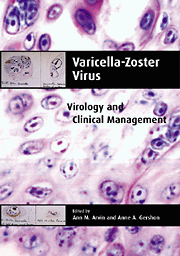Book contents
- Frontmatter
- Contents
- List of contributors
- Preface
- Introduction
- Part I History
- Part II Molecular Biology and Pathogenesis
- 2 Molecular evolution of alphaherpesviruses
- 3 DNA replication
- 4 Viral proteins
- 5 Pathogenesis of primary infection
- 6 Pathogenesis of latency and reactivation
- 7 Host response to primary infection
- 8 Host response during latency and reactivation
- 9 Animal models of infection
- Part III Epidemiology and Clinical Manifestations
- Part IV Laboratory Diagnosis
- Part V Treatment and Prevention
- Index
- Plate section
7 - Host response to primary infection
from Part II - Molecular Biology and Pathogenesis
Published online by Cambridge University Press: 02 March 2010
- Frontmatter
- Contents
- List of contributors
- Preface
- Introduction
- Part I History
- Part II Molecular Biology and Pathogenesis
- 2 Molecular evolution of alphaherpesviruses
- 3 DNA replication
- 4 Viral proteins
- 5 Pathogenesis of primary infection
- 6 Pathogenesis of latency and reactivation
- 7 Host response to primary infection
- 8 Host response during latency and reactivation
- 9 Animal models of infection
- Part III Epidemiology and Clinical Manifestations
- Part IV Laboratory Diagnosis
- Part V Treatment and Prevention
- Index
- Plate section
Summary
Introduction
Exposure of a susceptible individual to varicella-zoster virus (VZV) usually results in the clinical manifestations of varicella, in contrast to the other human herpesviruses, which are often acquired asymptomatically. Although symptoms of fever, malaise and vesicular rash occur in most cases, host responses play a critical role in limiting the progression of primary VZV infection. During the interval after mucosal inoculation, through the incubation period, the onset of varicella and the resolution of the acute illness, the virus first evades host clearance mechanisms and is then controlled by the induction of virus-specific immunity. VZV shares the characteristic of infectivity for cells of the host immune system that is common among viral pathogens. Like the human herpesviruses 6 and 7, VZV exhibits a tropism for T lymphocytes which is critical for the pathogenesis of primary infection (Moffat et al., 1995). Following mucosal inoculation, cell-associated viremia is presumed to be required for spread from regional lymph nodes to other sites of early viral replication in the liver, and viremia allows transport of VZV to cutaneous sites of replication during the late incubation period (Grose, 1981; Koropchak et al., 1989; Mainka et al.,1998).
Innate immunity may limit the initial spread of VZV within the host, but these defenses are usually not sufficient to prevent symptoms of illness before VZV specific adaptive immunity is elicited. Adaptive antiviral immunity consists of the clonal expansion of T lymphocytes and B lymphocytes that have the functional capacity to recognize specific VZV proteins and to interfere with viral replication and transfer of virions from infected to uninfected cells within the host.
- Type
- Chapter
- Information
- Varicella-Zoster VirusVirology and Clinical Management, pp. 142 - 156Publisher: Cambridge University PressPrint publication year: 2000
- 6
- Cited by



